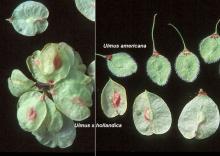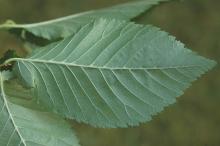Ulmus × hollandica
Common name:
Dutch Elm
Holland Elm
Hybrid Elm
Pronunciation:
UL-mus hol-LAN-di-ka
Family:
Ulmaceae
Genus:
Type:
Broadleaf
Native to (or naturalized in) Oregon:
No
- Broadleaf deciduous tree, a collection of hybrids of U. minor (syn. U. carpinifolia or U. procera) × U. glabra, and possibly others. Often the some 20 or so cultivars in this group look intermediate between the parent species, although selections may range in habit from tall, narrow or broad, to globose dwarf forms. Jacobson (1996) describes them as having hairless or sparsely hairy twigs, leaf undersides have inconspicuous to moderately obvious hair tufts, and vein pairs number (13)14-17(21). Some consider Ulmus × hollandica ‘Hollandica’ as the "type" cultivar of the cross. It is known as the Dutch Elm or Holland Elm in England and the English Elm in Holland, it originated in 1680 (Jacobson, 1996).
- Sun. Many are susceptible to Dutch Elm Disease (DED) but some are listed as resistant.
- Hardy to USDA Zone (4)5
-
A few of the cultivars of this hybrid are available in the U.S., they include:
- ‘Homestead' - a complex hybrid, which includes U. hollandica as a component in its genetic makeup and is sometimes listed as a hybrid of same. Upright with a good central leader, densely pyramidal to oval, rapid growing, to 55 ft (16.5 m) tall, arching with age.
- ‘Jacqueline Hillier’ (syn. U. elegantissima ‘Jacqueline Hillier’) - a slow growing rounded, densely branched shrub that grows to a height and width of about 8 ft (2.5 m). Can be grown in a container and as a bonsai.
- ‘Wredei’ [Golden Elm] - originated in Germany about 1875. Narrow pyramidal crown when young, oval to round with age, to 60 ft (18 m), leaves bright gold, shiny, small but wide.
- ‘Vegeta’ [Huntingdon Elm] - tall, with a short trunk that is usually forked, leaves light green, 7.5-15 cm long. May be the most popular older clone of U. × hollandica sold in North America (Jacobson, 1996).
- ‘Pioneer’ - hybridized in 1971 at a USDA station and released into commerce in 1983, resistant to DED, fast growing, crown densely round to oval, needs space, may reach 50 x 50 ft (15 x 15 m).
- Oregon State Univ. campus: the "Elm Walk" on lower campus, between 11th and 15th St., cultivar unknown. The trees making up the Elm Walk appear to have been planted in about 1905 under the direction of George Coote (1842-1908), an Englishman who was the first foreman of the Department of Horticulture and in time became its chair. Originally two species of elms were planted on either side of the pathway in an alternating pattern. The species were given as American and Cork Elms. In the spring of 1927 the American Elms were removed and replanted to more westerly regions of the campus to give space to the more rapidly growing Cork Elms. The Cork Elms may have been misidentified; they are now thought to be an unknow cultivar of Ulmus xhollandica.
Click image to enlarge





















